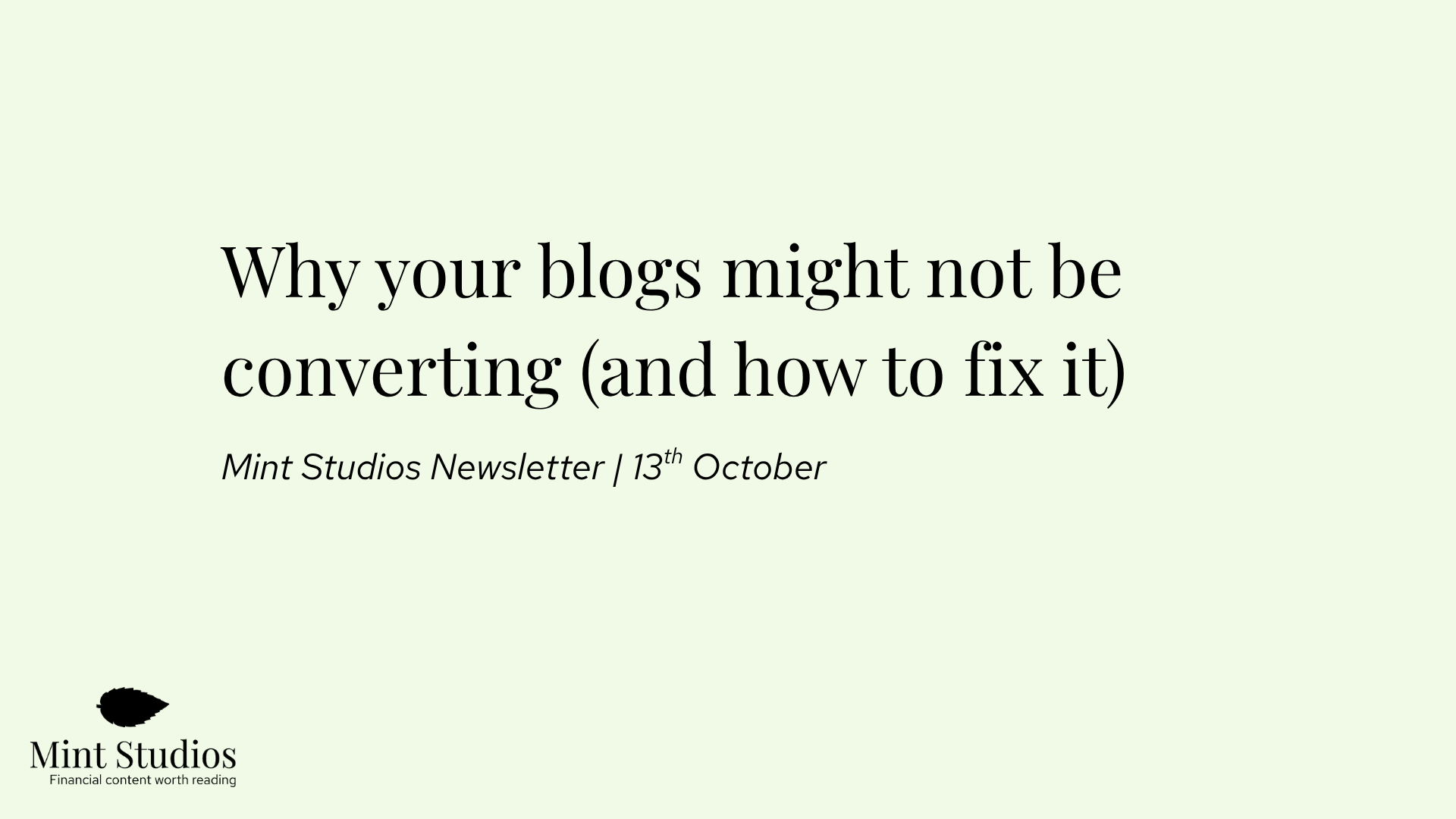At Mint Studios, we focus on helping financial services companies get business results with content marketing.
And a big part of how we do that is with Bottom of the Funnel (BOFU) content.
BOFU content allowed us to help bring in $1M+ in business opportunity for one payment client, helped turn content into the most cost-effective customer acquisition channel for a fintech company in Australia, and has helped multiple financial services marketers finally prove the contribution that content brings to the company they work for.
The premise is simple in theory, but hard in practice: Bottom of the Funnel content is content targeting prospects who are already aware they have a problem and are actively looking for a solution. In other words, people who are close to buying your product or service.
If you head over to your Hubspot or Google Analytics right now and look at which pieces of content bring in the most leads, you’ll likely see that most of your conversions are coming from 3 - 5 pieces of content. Most likely, those articles will be Bottom of the Funnel content.
If your objective is to get more business results from your content, then you need BOFU content to be part of your content strategy.
In this article we’ll be covering what BOFU content is, why it’s important, and how to write a good BOFU piece that is optimised for conversions.:
- What is BOFU content?
- Why is BOFU important?
- How do you create BOFU content?
- What’s in a BOFU article?
- What are some examples of BOFU content?
- How can you prove the results of your BOFU content
- Example of this in practice: how we helped Jeeves generate conversions with BOFU content
Note: we’re a content marketing agency that specialises in helping financial services companies acquire customers and position themselves as experts with content marketing. Learn more about what we do.
What is BOFU content?
In the world of marketing, the funnel is an imaginary funnel that your target market goes through before purchasing your product or service. It’s a conversion funnel, usually depicted as the following:
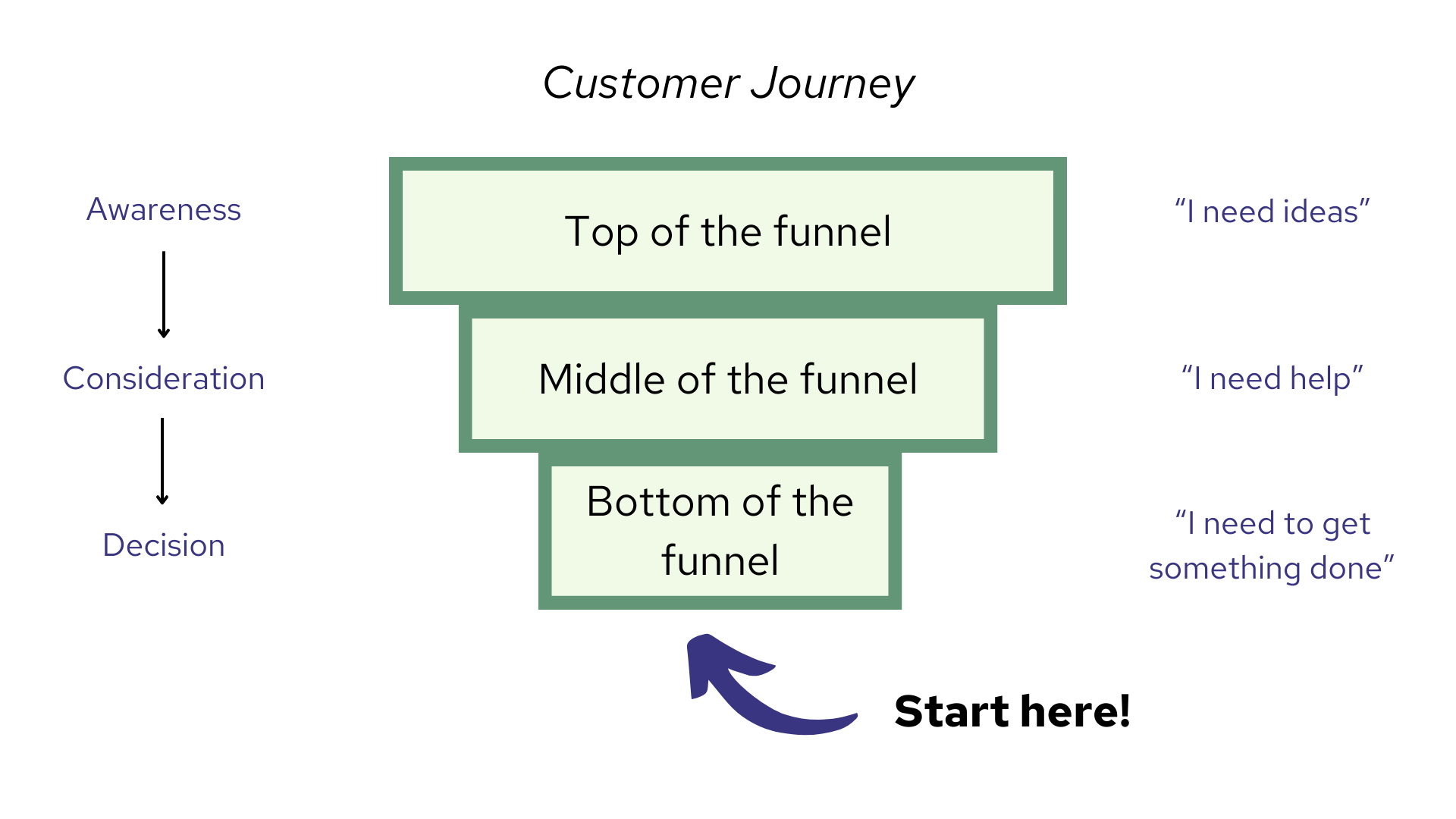
Buyers may not go through the funnel directly, since the buyer journey is a lot more haphazard and unpredictable. But that’s not the point: the funnel is a framework to segment users and make it easier to create targeted content.
Here’s how we imagine the reader when they’re at each stage of the funnel:
Top of the funnel (TOFU): Our reader might or might not be aware of their problem. They are likely looking for inspiration, ideas or opinion pieces. Keywords are phrases like “ways to save money,” “top investment experts” and “what is open banking”
Middle of the funnel (MOFU): Our reader has a problem and is considering a solution. They are doing their research and are looking for help. They most likely are looking for educational pieces, guides and how-tos. Keywords are phrases like “how to save for a pension,” “401k vs IRA” and “Open Banking vs other payment methods”
Bottom of the funnel (BOFU): Our reader is ready to take action. At the BOFU stage, they want to get something done. Maybe they’re comparing our product with someone else’s, or doing research about our brand and product. They have already been convinced to make a purchase decision, they just need to figure out how to and from where. Keywords are phrases like “Xero vs Freeagent,” “Robinhood alternatives” and “Open Banking providers”.
As we mentioned above, someone who is reading an article and looking for a list of “Open Banking providers” is clearly putting together a shortlist and will likely reach out to the list of companies they find. And it’s why your analytics will tell you that Bottom of the Funnel content is driving most of the conversions.
We’ve seen this across our clients as well. With Jeeves, a corporate expense card, the highest number of leads came from very BOFU topics.
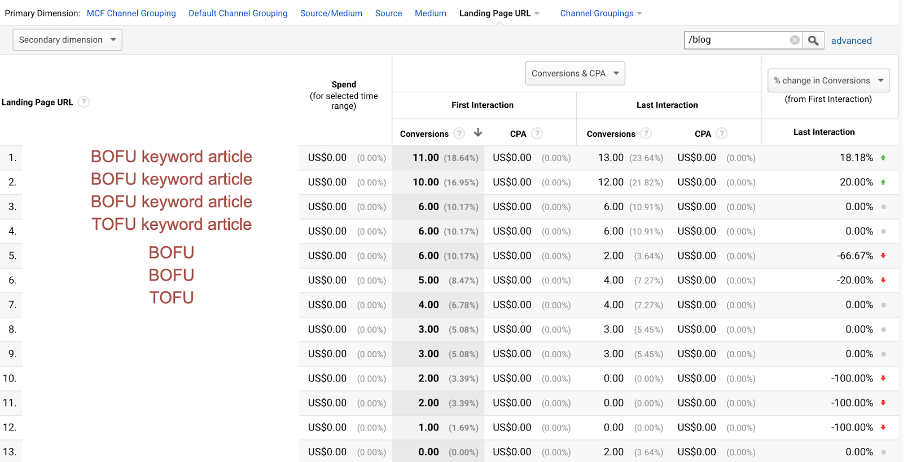
The same was for Zai, our payments client, where the most BOFU pieces of content – comparison posts – brought in the highest number of not just leads, but also quality leads that brought in deals.

What’s interesting is that as you can see in these screenshots, traffic wasn’t necessarily correlated to leads. The article that brought in the most leads did have high traffic, but the article with the second highest traffic only brought in 1 lead. In fact, most of the highest performing articles had under 500 pageviews. And that’s normal: when you create content that targets people close to buying, you care more about the “intent” behind the keyword, rather than the number of people searching for it.
That’s why we always say, an increase in traffic doesn’t always lead to an increase in conversions. And it’s why creating content with the sole focus of getting traffic, will rarely lead to business results.
You can learn more about keywords that are low volume, high ROI here: Low Volume, High ROI Keywords: Why You Should Include Them in Your Content Strategy
Let’s put this into context. Let’s make up a fake fintech company, where our product is a stock trading and investment app called Pine, and we help users invest in ETFs for their pensions/future.
At the TOFU and awareness stage, our potential customers are researching topics like “what is stock investing” and “stock market experts.” They may not know much about ETFs or how they can be used to help save for their pensions.
At the MOFU and consideration stage, they understand the power of ETFs and are therefore using keyphrases that are closer to the product, such as “benefits of investing in ETFs” and “ETF average fees.” It’s still mostly educational content, but clearly they have a preference over which type of product they’re interested in.
At the BOFU and final stage, they are researching phrases like “Pine vs Robinhood,” “how to start investing in ETFs” and “best investment apps.”
Of course, it never happens in one straight line. Some articles are both MOFU and BOFU (e.g. ETF pricing), and some people might be ready to buy right after reading TOFU content or seeing your content on social media. Again, this is just a framework to make it easier to create targeted content.
Most marketers will start their content strategy with Top of the Funnel content. But if you want business results with your content, it makes more sense to start with BOFU content and then work your way up to MOFU and TOFU.
Hopefully you now understand what BOFU is and next we will focus on why this content is important. This will also help transition into the next section.
To continue this conversation, you can read more about how we generate conversions with BOFU content.
Why is BOFU important?
The general culture of content marketing, which was initially driven by companies like Hubspot, is that you should invest in content as a channel, increase traffic, and eventually, some of that traffic will turn into leads and sales.
But it doesn’t exactly work like that. SaaS content marketing agency Grow & Convert were one of the first to go against this theory.
As they explain, if you say that “some traffic going to your blog will turn into conversions”, then you are essentially saying there is no difference between each piece of content you produce.
But that’s clearly not true. An article like “Pine vs Robinhood” or “Top Open Banking providers” will be researched and read by someone who is ready to buy. Whereas an article like “What is Open Banking” or “what is stock investing” will clearly be read by someone who is just doing research.
These are two separate articles targeting people with different intent, so it’s natural that they will have different conversion rates and bring in a different number of leads.
And that’s why it's so important to measure the effectiveness of each piece of content and to track the business results of individual articles, rather than the channel as a whole. If not, you could end up investing a lot into the wrong type of content (e.g. “What is Open Banking”) which won’t get you the business results you were hoping for.
If you want to get better business results from your content, then you need to first see which type of content is already performing well, and if repeated, will bring in even better results.
And that’s where Bottom of the Funnel content comes in.
Marketers like to use the analogy of a “marketing funnel” because you’ll have thousands or even millions of people at the TOFU stage, thousands or hundreds at the MOFU and hundreds at the BOFU.
If you input a keyphrase like “Xero vs Quickbooks” into a SEO tool like SEMRush or Ahrefs, you’ll see that the organic traffic is low — often under 100 searches per month. Does that mean it’s not worth it? Not at all.
Since we are optimising content for customers, not traffic, the number of searches per month is not as important (plus these tools are not totally accurate). The traffic that does come to your site from that keyword is a lot more high quality, which is what we want to optimise for. After all, you’d rather have 100 pageviews with a 2% conversion rate than 500 pageviews with a 0.05% conversion rate.
BOFU keywords are incredibly valuable because the search intent is clear: people who type in these keywords are ready to buy your product! Someone who is researching “Pine vs Robinhood” is ready to start, now! If you’re not producing content that targets these keywords, then you are literally leaving customers, and therefore revenue, on the table.
Based on the analysis we’ve done across the content we create for clients, we’ve seen that Top of the Funnel content typically converts at around 0.5%. But we’ve seen BOFU content convert as high as 8%.
In fact, with a client of ours we compared the business deals that came through via non comparison posts, vs those that came through via comparison posts (one of the most popular types of BOFU content).
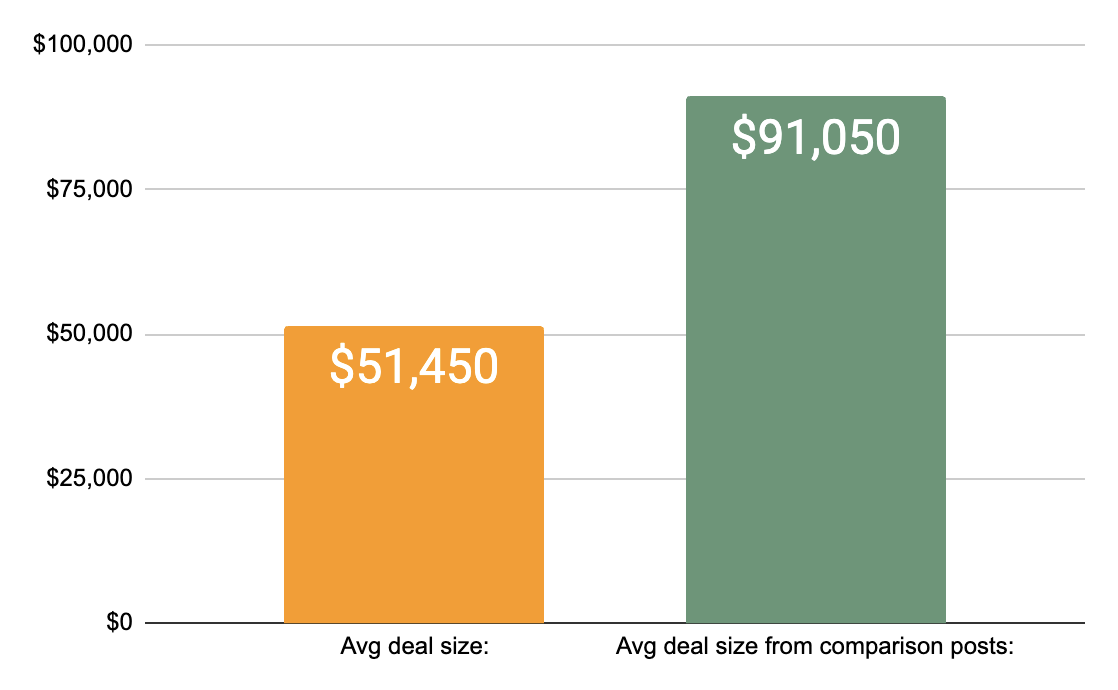
The difference between TOFU and BOFU content isn’t just a few negligible points. It’s not just a couple of more customers. It’s often 10x more customers. And as you can see via the graph above, the size of deals brought in via comparison posts was almost double the size of those that came via non-comparison posts.
Wouldn’t you want to invest more in the right content that drives better results?
That’s why when we first start creating content for a client and the focus is on business results, our content strategy starts with Bottom of the Funnel content. Then we’ll tackle the rest.
How do you create BOFU content?
Marketers typically approach keyword research and content marketing strategy by starting with a list of keywords, guessing what their target market might be searching for. Then, they prioritise by starting with keywords that have the highest search volume: this is the strategy promoted by Hubspot since the early 2010s.
But as you likely understand now, this approach will mean you’ll just end up with TOFU articles that won’t generate conversions. And if you’re hoping to get better business results with your content, then this is a strategy that won’t work.
So instead, you want to start by first figuring out what are the keywords that someone is searching that indicates that they are at the “bottom of the marketing funnel” and actively looking for a solution to their problem.
Over the past few years of doing this for our financial services clients, here’s how we approach it:
It all starts with understanding the pain points of your ideal customers. This is important because you cannot write content that explains why your product might be a good fit for the reader without first understanding what problems they’re facing. We get your team members on a call and ask questions like:
- What’s the story behind the company?
- How do you differentiate from competitors?
- Can you give me some examples of some of your best customers?
- What are their pain points?
- What question do prospects ask most often?
- Is it possible for prospects to solve their problems without X? How?
If possible, we also chat to your customers, and ask other types of questions, like:
- What benefits have you received from X?
- What would you do if you could no longer use X?
- What problem were you trying to solve when you came across X?
- What’s stopping you from using X?
You can read more about how we do this research here: How to Do Research for Bottom of the Funnel Content Marketing
This is very different to just asking for a document with a list of buyer personas, which we believe doesn’t give us a deep understanding of who you’re targeting. Instead, we prefer doing interviews, asking questions and listening to sales calls.
Once we understand the pain points, the rest is a lot easier. We do keyword research, yes, but only really to understand what words would our target audience use to find a solution to their problem. For example, do they use the word “refund employee expenses” or “expense reimbursement?”? (Turns out it’s the latter.)
In general, there are five types of BOFU content:
- Alternatives to e.g. “Alternatives to Quickbooks”
- Comparison articles, e.g. “Xero vs Quickbooks”
- Best of, e.g. “Best money transfer apps”
- Pricing, e.g. “Quickbooks pricing”
- Use cases, e.g. “USD to GBP money transfer apps”
That’s not to say you should only write those types of content. But make sure you’ve written those before you start writing Top of the Funnel content and other bits (if your focus is on generating conversions).
You can choose to use an SEO tool like Ahrefs or SEMrush to see what the search volume is. However it’s important to note that these tools often underreport on the search volume. In fact, some of our most successful articles had a search volume of under 50 – which is why it’s important to have a good understanding of who you’re targeting, that way you’ll know if this is something they’re searching.
We go into more detail about how to select the right keywords here: Low Volume, High ROI Keywords: Why You Should Include Them in Your Content Strategy
Getting the pain points and content ideas is just half the battle. The other half is creating high quality articles that would make a reader convert into a customer. And this is where things also go wrong: Bottom of the Funnel content is not content to entertain. You don’t need to use beautiful language or start with an amazing story — you just need to get to the point.
Writing a BOFU article is difficult because:
- The writer needs to be able to go into a lot of detail about your product.
- The writer needs to be able to write for a more advanced level of knowledge (especially in B2B).
- The writing itself has to be optimised for conversions, not entertainment or just traffic.
Articles such as “what is a pension” and “how to create a budget” can be written by anyone, because the writer won’t need to understand your product (or even the niche, since all the information can practically be found on search engines). But an article like “Xero vs Quickbooks vs [your solution]t” or “Pine vs Robinhood” requires understanding your product in-depth.
What’s in a BOFU article?
The BOFU articles we write often have:
- Screenshots of your product
- Product comparison tables
- Details about your product or competitor
- Expert knowledge of the industry from inside your company
- Expert knowledge of use cases
All of these above mentioned factors are why it’s quite hard to outsource BOFU articles. Which is why you can’t just hire a generalist freelance writer and expect them to know how to write your product.
Unfortunately, it’s the mistake that too many companies make, and then you end up with articles like this, articles that are meant to target CFOs but are instead very surface-level (does a CFO really need to know what a “startup accelerator” is?):

How do we fix this conundrum? At Mint Studios, we base all our content on interviews with people within our client’s team. We interview the sales team, the customer success team and if possible, the customers as well. This way we understand customer pain points as well as the intimate details of your product. We can write case studies, add screenshots, add expert knowledge from people in your team and even testimonials.
You can read more about how we do this here: Why You Should Create Content Based on Interviews With Experts
There are also a few things other things we do when creating BOFU content that helps enable conversions:
- Make introductions that are short and to the point. Read How to Write a Blog Introduction That Converts.
- No fluff. Only say what we need to say
- Add Call to Actions (CTAs) wherever it makes sense (I like to add one right after the intro and at the end).
- Write for the knowledge of your reader. Especially if you are in B2B, don’t write for a 5 year old. Write for their knowledge.
- Make it easy to read. As a content marketer, I care a lot about the reading experience. I always prefer font size 20, black font, 4 line paragraphs and images that add value to the discussion.
- Focus on product features and benefits. Someone at the Bottom of the Funnel is looking for product information since they are trying to make a decision. Make sure you include the right features and benefits that they would be interested in.
You can learn more about how to write good BOFU content here:
- How to Create Content that Speaks to Your Customers' Pain Points
- How to Write About Your Product In Your Content [And Increase Conversions]
- The Huge Opportunity for Content Marketing in the Payments Industry
What are some examples of BOFU content?
What you are currently reading is not BOFU — we would say it’s more MOFU content since we are providing educational material. So what is BOFU? What are some examples?
Best Stripe Connect alternatives for Australian businesses
This is an example of a comparison post we wrote for our payments client, Zai, that brought in quite a few leads.
[Best] invoice finance providers
Another example of a comparison post listing aiming to teach people about the industry and explain the key value propositions of Financefair.
Direct Debit API: How to set one up (and when to use one)
Great example of a more technical piece of content for a technical audience. We call these “use case” posts since they are targeting people who are looking for a specific use case for an API.
How to add the right age verification system to your business
Another post that’s targeting a “product keyword”. Persona does age verification so it makes sense to target this keyword with more technical and advanced content.
Payment Initiation: How to collect instant payments
An example of an article targeting a keyword that is both a use case and product-oriented, for an embedded payments company, Modulr.
Wave Alternative In Australia: Parpera
A different type of comparison post that is more for B2SMB.
You can read more BOFU content we’ve created for clients here: Mint Studios Results
How can you prove the results of your BOFU content?
What’s very powerful about creating BOFU content is that it generates business results, but this is all for nothing if you cannot prove the business results you’re bringing in.
Although 100% accurate attribution is never possible, we believe that measuring as much as you can is better than not measuring anything. Having some idea of what’s working is key to directing your marketing strategy and ensuring you’re on the right path.
With Hubspot and Google Analytics, you can track lead generation, MQLs, SQLs and even revenue a piece of content helped generate. A big part of what we help clients with is not just creating the content, but also tracking the results and proving the contribution of content to the business.
With first and last click attribution, you can see which pieces of content brought in brand new leads, helped influence existing ones and what the customer journey was.
There are 6 Hubspot reports that we like to use and set up, that allow us to track a few metrics:
- New contacts
- New leads
- New deals and revenue with content
With the right reports, we’ve been able to prove that the content we created helped generate $1M+ in business opportunity.

And you can too, with the right reporting. Having this information is incredibly powerful as a marketer. It lets you:
- Prove the business results of your content marketing efforts, therefore making a business case for a bigger marketing budget.
- Understand better what is and isn’t working, allowing you to better direct your marketing strategy. If you know that certain topics and articles are bringing in leads and revenue, then it’s a good indication that you should create more content focused on those topics
- Show how content is helping grow the business, allowing you to get taken more seriously by the team.
You can read our guide to setting up these reports here: How to Track the Quality of the Leads Your Content Brings in [With 6 Hubspot Reports]
Example of this in practice: how we helped Jeeves generate conversions with BOFU content
We’ll take a real life case study of how we used BOFU content to help Jeeves, a corporate expense card, generate leads with content.
We started off working with Jeeves by spending a few weeks interviewing the sales team and understanding who their ideal customers were and what their pain points were. When we put together the strategy and calendar, we prioritised the topics and keywords that we believed would bring in the most conversions first.
These were keyphrases like:
- Accounts payable software
- Spend management for finance teams
- Virtual business credit cards
Since we were targeting CFOs and professional people in finance, we needed to make sure we were writing for their knowledge level and not absolute beginners (in other words, not keywords like “what is accounts payable”). To do this, we interviewed experts on the Jeeves team knew the problems in depth with corporate expense management. This allowed us to create content that resonated deeply with the readers.
After a few months, we were able to see leads come in via the content. And as expected, the more BOFU the piece of content was, the higher the conversion rate.
We were able to increase leads by 10% month over month, get Jeeves high in the rankings for key phrases, and see conversion rates from pageviews to qualified leads as high as 2.4%.
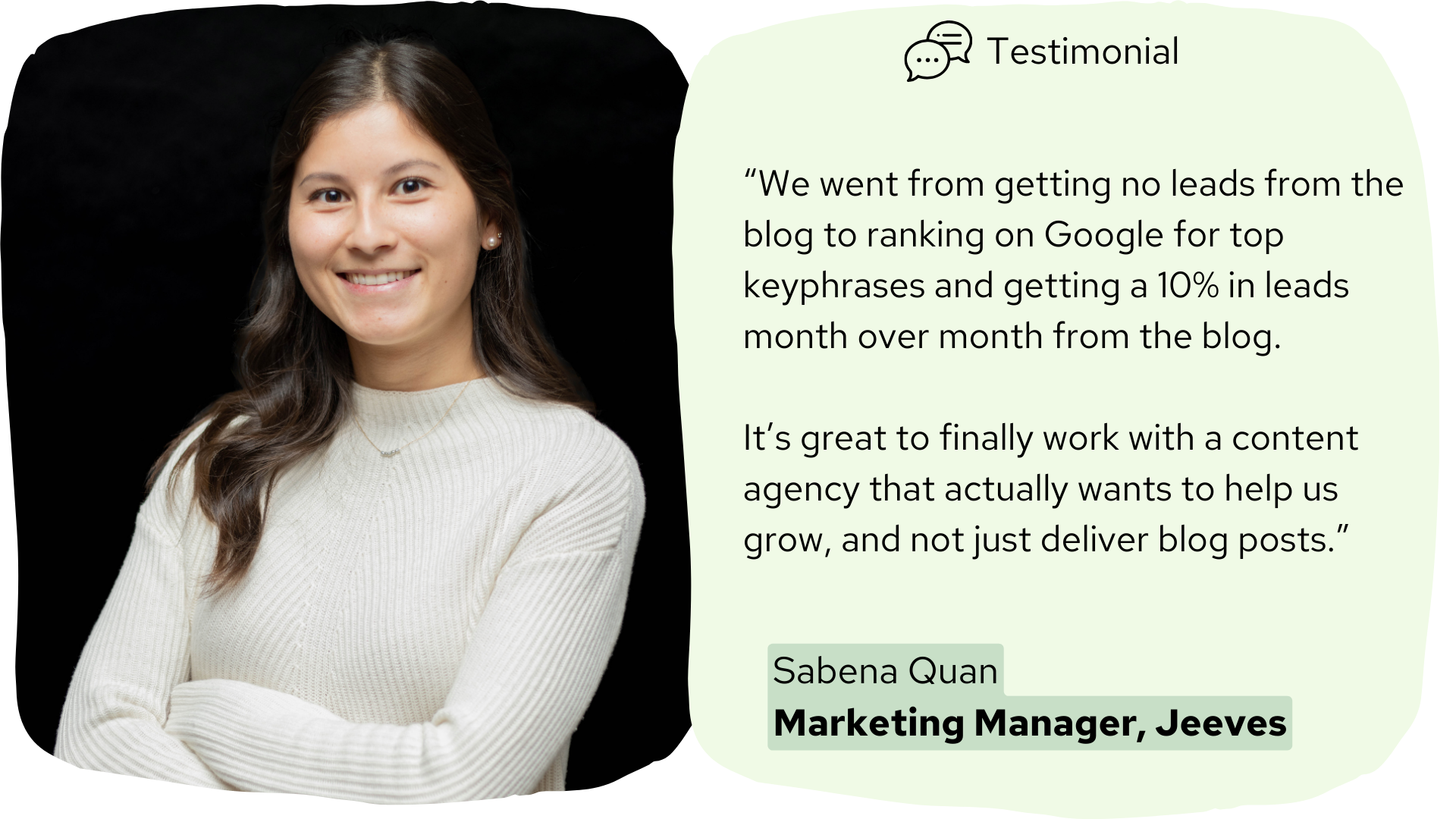
You can read the case study here: Jeeves Case Study: Creating Content That Raises Awareness and Brings in Leads
BOFU content: an absolute must if you want to get business results from your content
If you’re a marketer or work for a company and want to create content that generates business results, then BOFU content should be part of your strategy.
With this article, you now hopefully understand why BOFU is so important and why it should be the first thing on your list — in our opinion — if you want to generate qualified leads and customers with your content marketing.
If you’re in-house at a company, start by doing some research and finding out your customer pain points. If you are offering content marketing services, interview your client to understand their customers’ pain points, and start creating content around that angle.
If you want to learn more about BOFU content and content marketing, sign up to our monthly newsletter and you’ll get all our upcoming articles in your inbox.
Looking for content marketing support? Mint Studios is a full service content marketing agency that helps turn your fintech blog into a customer acquisition channel. How? We start with BOFU content, and use the Mint Studios framework. You can read more here.
BOFU content Frequently Asked Questions
1. What is Bottom of the Funnel (BOFU) content?
BOFU content targets prospects who are already aware of their problem and actively looking for a solution. These readers are close to making a purchase decision and often search for high-intent keywords like “Xero vs QuickBooks” or “best investment apps.”
2. Why is BOFU content important for business results?
BOFU content converts at much higher rates than Top or Middle of the Funnel content because it aligns directly with buyer intent. Across client campaigns, Mint Studios has seen BOFU pieces convert up to 8%, compared to 0.5% for TOFU articles — often delivering significantly larger deal sizes as well.
3. How is BOFU content different from TOFU and MOFU content?
TOFU content focuses on awareness and education, often targeting beginners or broad topics. MOFU content provides more in-depth guidance for those considering solutions. BOFU content, however, speaks directly to buyers ready to act, providing product details, comparisons, pricing, and use cases that support a purchase decision.
4. What types of BOFU content perform best?
The five most effective BOFU formats are:
- Alternatives to… (e.g., “QuickBooks alternatives”)
- Comparison articles (e.g., “Xero vs QuickBooks”)
- Best of lists (e.g., “Best money transfer apps”)
- Pricing pages (e.g., “QuickBooks pricing”)
- Use case content (e.g., “Direct Debit API: How to set one up”)
5. How do you find the right BOFU keywords?
Instead of chasing high search volume, start by interviewing your sales team and customers to understand pain points and buying triggers. Then identify the terms they actually use when searching for solutions. Even low-volume keywords can deliver high ROI if the search intent is strong.
6. How can you track the results of BOFU content?
Use tools like HubSpot and Google Analytics to measure leads, deals, and revenue generated per article. Track both first-click and last-click attribution to see which pieces bring in new prospects and which influence existing ones. This data proves ROI and informs future content strategy.











